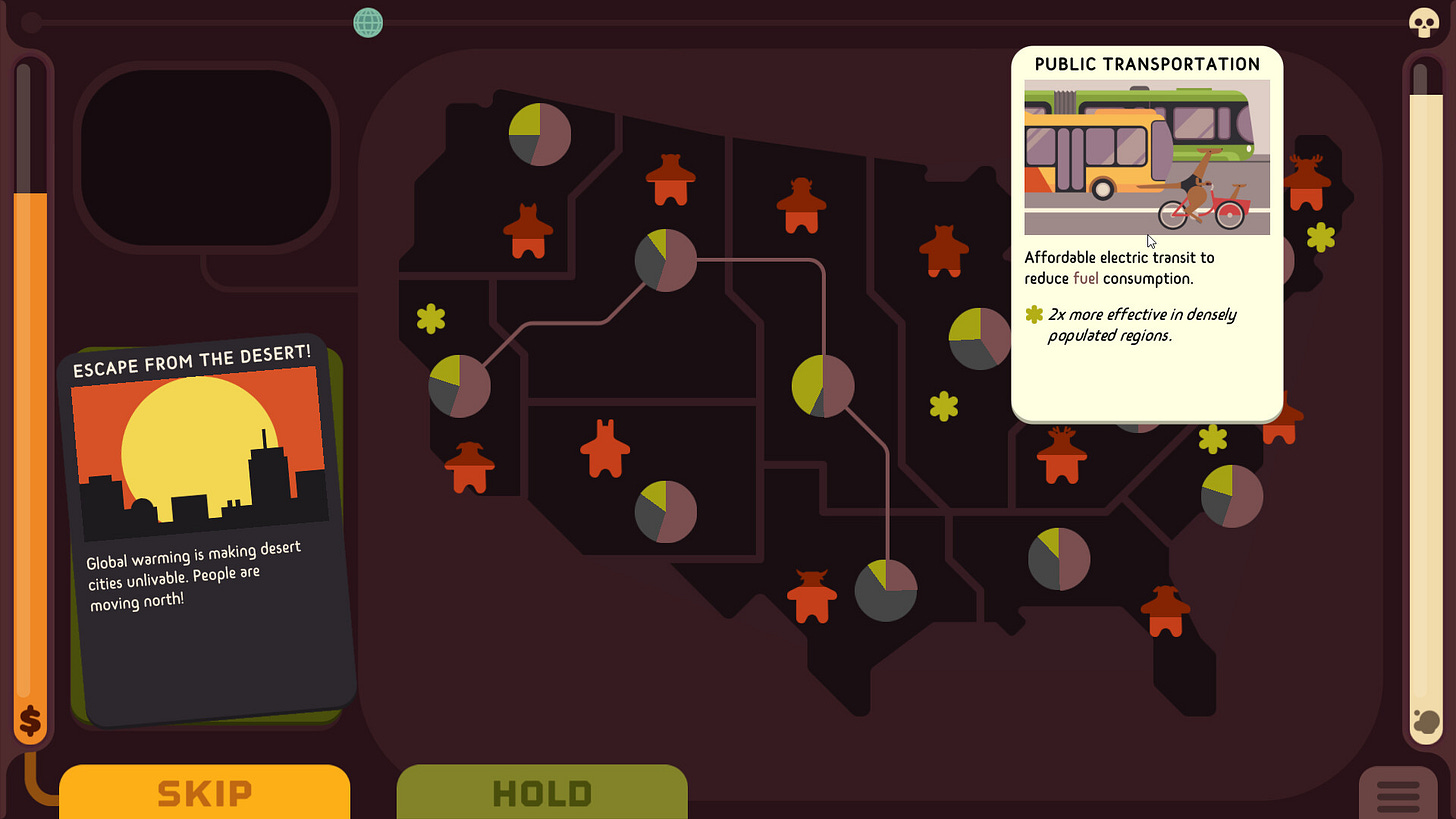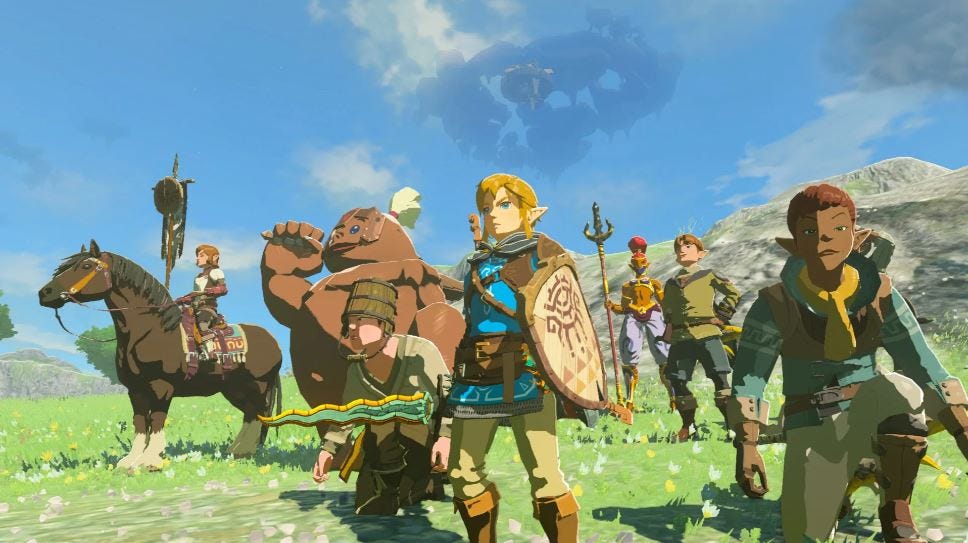Press Right to Repair your Xbox Controller
Your latest digest of video game and climate change news from the past two weeks.
Welcome to the latest edition of Play Anthropocene!
Today is Tuesday, August 8th, and we’re covering the latest developments in the world of video games and climate change. Happy reading!
Decarbonise America in 30 minutes or less with Green New Deal Simulator
One of the key concerns often raised around the transition to a green economy relates to jobs. What happens to the millions of people who currently rely on the fossil fuel industry for their livelihoods? How do we ensure a just transition for an entire workforce? In other words, is there a way to safely and securely migrate workers across to the millions of new professions that will be created from green industries? These are valid queries, and ones that, so far, games have largely avoided addressing.
Enter Green New Deal Simulator, which uses employment as a key tension within the design of its bite-size experience. In developer Molleindustrai’s latest title (free on Steam and Itch.io), players take on the position of America’s Green New Deal Secretary, tasked with transitioning the country to a zero-carbon economy before the impacts of climate change get bad enough for an eco-fascist government to force its way into power.
With each of your policy choices represented by cards, you must balance out the need to invest in renewable energy, draw down fossil fuel consumption, and electrify the grid against the constraints of not just your government budget, but unemployment fluctuations caused by your legislation. Invest in public transport, for example, and parts of the US with a heavy automobile industry presence may see a notable loss of jobs, which may need offsetting with something like the Job Transition card, offering legacy workers new training and unemployment benefits in the interim.
If a certain region of the country hits an unemployment threshold, Green New Deal Simulator prevents you from being able to enact any further policies without addressing it first, stressing the need to keep a close eye on unemployment levels as you play. It’s a smart, simple way of recognising the importance of jobs as a risk factor in the path to net-zero, even if some aspects of GNDS’ presentation of the problem can feel inherently reductive (as Ben Abraham brilliantly outlines here).
Green New Deal Simulator isn’t the first title to use the digital card game format to emulate the decarbonisation struggle. Earlier this year, Beecarbonise reframed the turn-based card battler experience in order to challenge players with fighting the global climate crisis itself, and GNDS’ lead designer Paolo Pedercini recently told Game Developer why the genre proves a good fit for the invoking the tension between the quest for net-zero, and the many obstacles that get in its way.
“I like the skeuomorphism of playing cards in video games because they instantly communicate aspects of chance and probability, as well as common affordances like “drag to play” or discard.” explains Pedercini. “They are also able to represent heterogeneous actions. Had the game been a top-down tycoon game, things like public transportation, job training, or insulation retrofits would have been more difficult to visualize as objects you drop on a map.”
By deliberately limiting itself to a specific context, Green New Deal Simulator is able to telegraph more nuances about the inherent tensions and challenges of decarbonisation, and the ways in which it is affected by geography, economics, politics, and much more. As for how long it took me to ‘beat’ the game - I got there on my third go. Why not give it a try, and see if you can undercut my record?
Parley Anthropocene: Rounding up the games and climate conversation
This week, we’re trying out a new section on Play Anthropocene; one in which I round up some of the most pertinent quotes on games and climate from the previous two weeks (or, in this case, the previous month, given the newsletter’s brief holiday hiatus over the July period).
I won’t be running Parley Anthropocene (*ahem*… you have to say it like a cowboy, otherwise it doesn’t really work) with every edition of the newsletter, but sometimes there’s just so many good words out there from folks much smarter and more articulate than myself, that it’s nice to be able to appreciate them on their own terms, commentary free. Okay, here we go…
"A big thing is, in the games industry, I've seen a little bit of apathy when it comes to sustainability, primarily because people still have a really outdated view of who gamers [are]. And when I tell people that gamers are more likely to be vegetarian, that overwhelmingly gamers think that they're being impacted by climate change… people kind of tend to have this view of a gamer being a specific person, they don't think that this is true. But actually, people who play video games are a fairly progressive audience that care about that sort of stuff.”
Yrs Truly founder and managing director MJ Widomska, speaking at Develop: Brighton last month. Widomska also spoke more at length with GamesIndustry.Biz on what it takes to run a B Corp certified game studio.
“Ecofiction is all about reframing our ideas of story to look critically at our relationship with the environment. Both Breath of the Wild and Tears of the Kingdom tell stories using their worlds, yet, more importantly, they treat the dynamic relationship between the player and the world—exploration, survival mechanics, emergent gameplay within a virtual nature—as a meaningful story in itself. This may not be as flashy as a movie or as idea-driven as some novels, but these games demonstrate a fundamental shift in our understanding of where ecofiction might productively occur.”
I really enjoyed this LARB essay from Martin Dolan, expounding on The Legend of Zelda: Tears of the Kingdom’s environmental subtext. We already touched on these parallels briefly at Play Anthropocene in the Spring, but Dolan’s words are the best analysis on the subject I’ve read yet.
“Facts and data can leave one feeling disempowered and disengaged. Immersive experiences like ours are more powerful than talk of environmental disasters that are already in the media every day. It’s a positive approach rather than an apocalyptic one.”
This one comes not from a games industry spokesperson, but Misha Curson, Senior Arts Curator at The Eden Project in Cornwall, UK. It’s part of a wider feature from The Guardian exploring the impact and resonance of eco-art, and while it doesn’t refer to games explicitly, there’s a lot of relevant commentary in there to chew on.
Xbox leads the games industry’s first, much-needed steps into Right to Repair
In the past, games console manufacturers have played a hard and stingy game when it comes to collaborating with consumers in the right to repair their hardware.
Switch Joy-Cons experiencing drift? Send it in to Nintendo’s repair centre, reportedly overburdened with orders and horrendously understaffed to the point where your console might come back to you in worse condition than when you sent it off. Want to open up your PS4 to clean out some of the dust causing its fan to go nuts? That’ll require removing Sony’s “Warranty void if seal removed/damaged” sticker which, until recently, allowed the publisher to wash its hands of responsibility for keeping their consoles working.
Such efforts, alongside the typical planned obsolescence design features, has resulted in a system that encourages consumers to buy new hardware when something goes wrong, rather than repair the item they already own. The games industry isn’t the only place that commits these sins, of course, but - as microplastics enter the bloodstream and a garbage patch twice the size of Texas covers the Pacific ocean - the need to curb capitalism’s consumerist churn is more urgent than ever.
Thankfully, the Right to Repair movement, which advocates reforms that make it easier for consumers to repair the products they own, has finally made its way to the games industry, resulting in some positive shifts in recent years. In 2021, the US Copyright Office acknowledged the Right to Repair by ruling on an exemption in the Digital Millennium Copyright Act that allows consumers to repair software-controlled devices that they own, including games consoles and accessories.
Two years later, and it looks like Xbox is finally making good on that ruling, allowing users to buy modular parts for its Xbox controllers, and producing detailed instructions for disassembling and repairing the products. Currently, these services are only available for the Xbox Elite Controller 2, but it sounds like Microsoft is rolling this out as a pilot program to gauge interest, before potentially expanding to other products in its line-up.
Could we eventually see a future where customers can easily and affordably repair their own Xbox consoles? It would have certainly made Microsoft’s job a lot easier (and less expensive) back in the Red Ring of Death days. In any case, if you find your Xbox Elite buttons starting to play up, or perhaps the triggers feel a little inaccurate, don’t throw it out! Buy in some parts, and let Microsoft know that there’s an willing and ready customer base out there, one smart and sensible enough to make use of our right to repair, and allow our existing hardware to last for as long as feasibly possible.
Enjoyed this newsletter? Subscribe or spread the word about Play Anthropocene to others who might be interested, and if you have any feedback or questions, feel free to get in touch with me at PlayAnthropocene@gmail.com
Find me on Twitter: @alexavard95







